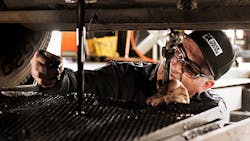Maintaining engine cooling system components is critical not only to avoid breakdowns, but also to ensure the truck is operating effectively throughout its lifecycle. Experts weigh in on what to check for as part of a cooling system maintenance program.
Homer Hogg, director of technical service for TravelCenters of America:
Engine cooling systems have evolved over the years to keep up with exhaust gas recirculation and other emission and fuel efficiency technologies. As it relates to preparing and maintaining a commercial truck for the heat, not much has changed. It’s true that today these systems have different coolants and metal protection strategies as the industry adapts to newer technologies, but the inspection process is still very much the same.
Belts, for example, have evolved from a V-style to a V-ribbed design. These belts utilize belt gauges that differ greatly from what we used years ago. The old method of just visually inspecting the belt and using a Krikit gauge to check tension is virtually gone. Today’s belts are made of ethylene propylene diene monomer and can last 100,000 miles or more. It’s impossible to properly inspect these belts just by looking at them or checking tension. A technician must know how to use the correct belt gauge.
Flushing the system and using the right coolant mix and water dilution is also very important. Over time, contaminants from seals, oil, fuel and sometimes from poor service practices enter or are released into the cooling system and must be removed. Remember that coolant is composed of around 50% water and can rust or cause metal flaking in the engine. These contaminants must be removed by flushing the system.
Check the engine fan to ensure that it cycles properly and is in good mechanical condition, and that the shroud and all mounting hardware are also secured and in good working condition.
Because engine oil circulates throughout the engine and keeps it cool, keeping to proper oil change intervals will maximize the effectiveness of the oil.
Lastly, perform a pressure test on the engine cooling system to be certain that no leaks are present. Correct any defects immediately to help keep your vehicle running safely and on time.
Dan Holdmeyer, industrial and coolants brand manager for Chevron:
Keep the system full, check and maintain the proper concentration for proper freeze and boil-over protection, tighten clamps to stop any leaks, check color to note any contamination or coolant break down, check for additive concentration, and check the radiator cap for proper sealing.
Even though caps cannot be overtightened because of stops on the radiator fill port threads, ensure the cap seal is not damaged and that the pressure-maintaining spring is not broken. A radiator cap pressure tester can be used to verify this.
Coolant Categories
The general categories for coolants include:
- Inorganic acid technology (IAT) coolants contain silicates. Green or pink in color, this coolant type has been the conventional standard for coolant for a number of years. The inhibitors are derived from silicates and phosphates. These deplete and routinely must be changed out.
- Organic acid technology (OAT) coolants are a nitrite-free extended-life coolant (ELC) formulation. OAT coolants do not require the use of additional supplemental coolant additives (SCAs).
- Nitrited organic acid technology (NOAT) coolant works similar to OAT coolant performance-wise, but includes nitrite for additional pitting protection. This is an extended life coolant.
- Hybrid organic acid technology (HOAT) extended-life coolant combines some of the inhibitors used in IAT and OAT coolant formulations.
For any vehicle service, fleets should refer to the manufacturer’s specifications for proper coolant use.
About the Author
John Hitch
Editor
John Hitch is the editor-in-chief of Fleet Maintenance, providing maintenance management and technicians with the the latest information on the tools and strategies to keep their fleets' commercial vehicles moving. He is based out of Cleveland, Ohio, and was previously senior editor for FleetOwner. He previously wrote about manufacturing and advanced technology for IndustryWeek and New Equipment Digest.

